Some anime I’ve watched recently:
Angel Heart – adapted from a manga by the same writer who gave us City Hunter. This is a City Hunter spin-off. A girl assassin who has been trained as an assassin from a very early age has had enough of killing after her 50th job and commits suicide. The syndicate steal a transplant heart after, apparently, Â killing its owner, and transplant it into the assassin (actually, since she has just jumped off a high building, one might wonder if this is sufficient).
The assassin, unconscious for a year, has strange dreams in which the former owner of the transplanted heart urges her to live. The dead owner of the transplanted heart is Kaori and her grieving husband is Ryo.
Not great, but the character designs look good.
Kemonozume – an odd anime, already starting to slip from my mind since this morning. Human-eating demons live among the human population, and a clan of demon fighters is dedicated to getting rid of them. However they are short of experienced fighters. The clan leader is ageing, and one of his sons wants to continue with traditional methods (swords) while the other advocates modern hi-tech methods (robot suits). There are a couple of women involved, one a nice clan menber, the other a rather demonic hot sexy blonde. It has a rather spiky modern animation style
Negima?! – Actually I gleaned much more about this series by looking it up on the Web than I did by watching the first episode. Ten-year old apprentice wizard Negi is sent from Wales to act as a supply teacher in a Japanese middle school, as part of his training. (This would be a tough assignment for an adult, let alone a wimpy ten-year old boy). So, he arrives and has to handle about thirty cute fourteen-year old girls. There are two Negima TV series and this, the second one, is a “retelling” – in other words both have exactly the same synopsis. It bears more than a little resemblance to “Love Hina” in which a limp boy had to contend with a dorm full of feisty girls - in fact the Negima girls’ characters map those in Love Hina.
If you ask me, it would be better to just get “Love Hina” and watch it again.Â
Red Garden – set entirely in New York. A spate of deaths sets off an investigation. Young clubbers are unable to remember what they were doing the night before, but it seems it was something nasty. And IIRC they have also become undead.
Taiyou no Mokushiroku – comes in two parts, each near feature length. A series of devastating earthquakes, accompanied by tsunami and eruptions, devastates Japan. The influential Ryo family suffers loss as the son and his wife are killed, and the grandson appears as a plucky survivor before vanishing. The damage is so severe that Japan literally splits in two and has to accept the “help” of the Americans and Chinese for rescue and reconstruction.
Part 1 fast-forwards 15 years to a scene in Taiwan, where Japanese refugees are still stuck in camps unable to return home, and there is bad feeling between them and the locals. The grandson, Genshiro, is in Taiwan, living as a Taiwanese. Remembering his roots, he gets into trouble by sticking up for the Japanese refugees.
Particularly towards the end of Pt.1, I found this lengthy epic rather simplistic, with the characters falling into types e.g. Good-hearted Gangster, rather than having any depth. It also irritatingly shows the Japanese in their “look how insecure and helpless we are” mode. If you swallow any of this bullshit, and I don’t mean this unkindly, just remember that three generations ago the Japanese were invading Asia and trashing China, and that now they have one of the largest armed forces in the region, and we’re all buying their cars and electronic gizmos.
Venus Versus Virus – a traditional theme with a secret clan battling people-eating demons. Despite the title, it’s not much to do with viruses of either the cybernetic or medical varieties – they just call the demons “viruses”. That cute schoolgirl is recruited to the team and does her best. Actually it’s not bad.
Strike Witches – Witches with rocket boosters attached to their legs act as an airborne defence force. Quite the most stupid anime I have seen in years, and also one of the funniest.

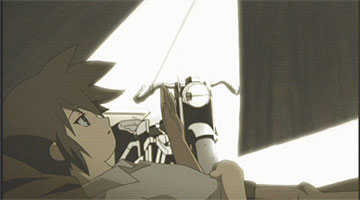 Kino and Hermes
Kino and Hermes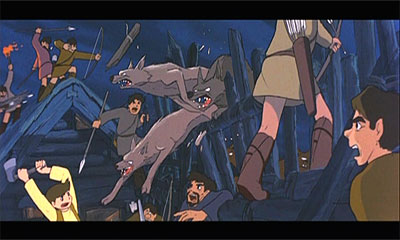 Wolf attack
Wolf attack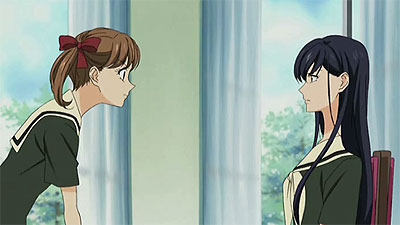 Yumi & Sachiko
Yumi & Sachiko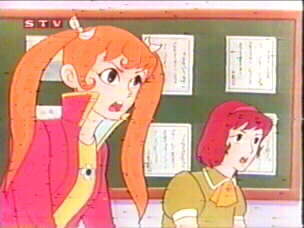 Tickle
Tickle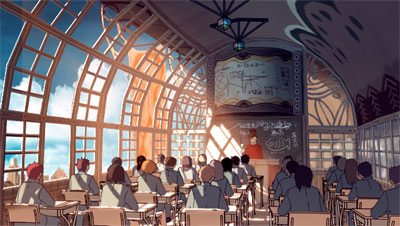 Classroom scene
Classroom scene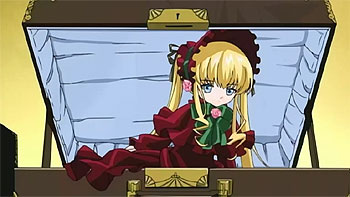 Shinku in her case
Shinku in her case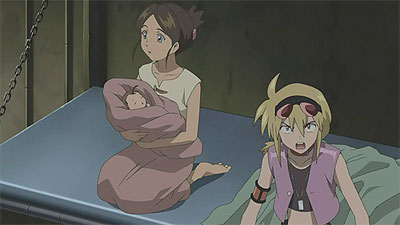 Isla and Ked
Isla and Ked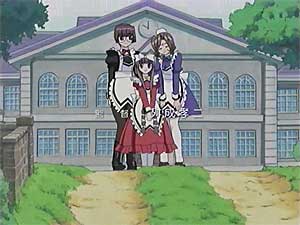 Kokoro is the youngest of three sisters who run the Kokoro Library founded by their father. The library is big enough to serve a city, but is situated in remote coutryside, and consequently is rarely visited. On Kokoro’s first day at the front desk, there is just one visitor, a young woman who borrows a book that she read as a child. A week later nobody at all turns up on the day appoined for this book’s return.
Kokoro is the youngest of three sisters who run the Kokoro Library founded by their father. The library is big enough to serve a city, but is situated in remote coutryside, and consequently is rarely visited. On Kokoro’s first day at the front desk, there is just one visitor, a young woman who borrows a book that she read as a child. A week later nobody at all turns up on the day appoined for this book’s return.